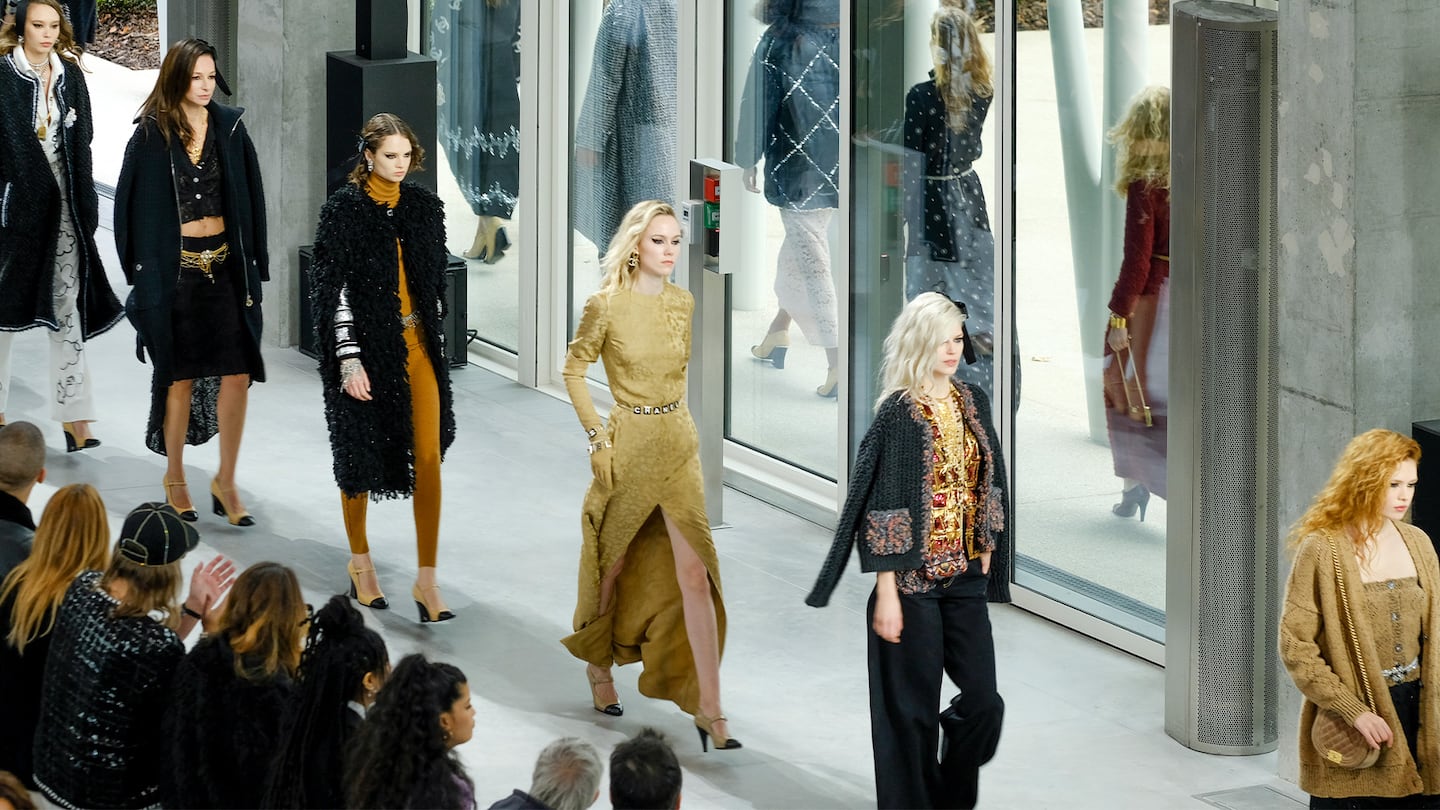
The Business of Fashion
Agenda-setting intelligence, analysis and advice for the global fashion community.

Agenda-setting intelligence, analysis and advice for the global fashion community.

PARIS — Chanel may be most closely associated with its birthplace on glitzy Rue Cambon and the neighbouring Ritz Hotel where founder Coco used to live. But for the 20th edition of its annual “Métiers d’Art” show, which is dedicated to showcasing top-end suppliers the brand has been steadily acquiring since the 1980s, the luxury megabrand invited guests to Paris’ scruffy northern edge, where it is set to inaugurate a 25,000 square-metre craftsmanship hub early next year.
Dubbed the 19M, the campus brings together 11 of Chanel’s most notable subsidiaries including embroiderer Lesage, feather-and-flower specialist Lemarié and hat maker Maison Michel (which has grown into a brand in its own right). Six hundred employees are being transferred to the new facility with plans to hire an additional 100 per year, Chanel said.
0 of 59
Their work was deployed in designer Virginie Viard’s latest Métiers d’Art collection, which featured graffiti motifs embroidered from coloured beads and multi-coloured ostrich feathers woven to resemble the house’s signature tweeds. If the couture-level craft was the stuff of another era, many of the silhouettes were decidedly of today, with relaxed tweed trench coats layered over midriff-baring tops and flowing, wide-legged trousers.
“Virginie is a woman of products and style,” said Bruno Pavlovsky, Chanel’s president of fashion. “She wants to design collections for the women of today.”
ADVERTISEMENT
But producing those designs at the scale of a $12 billion-per-year brand is no easy feat, as the company juggles rising demand with increased pressure on the fashion industry to curb its environmental impact and guarantee better labour conditions.
That many of the artisans on which Chanel depends are reaching retirement age and may prove difficult to replace has added another dimension to the challenge. Brands including Hermès, Louis Vuitton, and Prada have also been adding sparkling manufacturing facilities in recent years to attract younger employees and ramp up in-house production.
“Our industry is undergoing a complete transformation,” Pavlovsky said. “It’s not just about using the best quality materials, but also about the provenance, the traceability and the conditions in which they are produced.”
Chanel’s Métiers d’Art programme is critical to helping the brand navigate the shift, as it ramps up the pace of supplier acquisitions and directs its focus further upstream.
What started with a focus on image-generating embellishments — the company used to mostly acquire prestigious suppliers who could lend their expertise to visible details, like intricate lace, or furnish accessories like brass jewellery, gloves and hats to complete a look — has become a more strategic play as the brand aims to control more elements of its supply chain. Chanel has snapped up seven manufacturers over the past two years, including threadmaker Vimar, tannery Gaiera and knitwear factory Paima.
Chanel’s supply chain acquisitions now total 41, up from only a dozen a decade ago, and employ 6,600 people. While these suppliers have a key role in helping Chanel flex its craftsmanship muscle at runway shows, they also increasingly play a part in producing commercial products.

Around one-third of Chanel’s manufacturing now takes place in house, Pavlovsky said. This is higher than at most Italian luxury brands, which depend heavily on the country’s dense network of thousands of sub-contractors, but lower than top-end rival Hermès, which has said it produces 85 percent of products in its own French workshops.
Future-Proofing the Supply Chain
ADVERTISEMENT
Raising the share of products made in-house is not a goal in itself, but rather the result of a series of moves aimed at future-proofing the brand’s supply chain. Having its own tanneries and threadmakers not only helps ensure Chanel’s supply of materials, it also provides a laboratory for innovation both on products and on processes to improve sustainability, Pavlovsky said.
“If Chanel wants to exist in 10 or 15 years, all of the actors in our supply chain need to transform,” he added.
Still, even as the brand exerts greater control over its production, Chanel does not trade in raw materials, limiting its visibility of the most important driver of its environmental impact. Traceability “is the top priority” for Chanel’s supply chain, Pavlovsky said, but it remains elusive.
“We’ll still need some more months — I wouldn’t say years — to be able to assure this,” he said. “It’s a mindset change for houses like Chanel, and for all of the players upstream.”

Communicating on sustainability and ethics to the traditional heritage, craftsmanship and creativity credentials that luxury brands communicate may help to justify higher prices.
Chanel raised prices on key items three times this year on top of hefty increases the year before, attributing these hikes to the rising cost of materials and exchange rate fluctuations.
“Chanel embodies ultimate luxury,” explained Pavlovsky. “That means procuring the best materials, and it’s the reality that producing these items has become more costly in recent years. Covid undoubtedly accelerated that increase.”
He said clients understand why Chanel’s products are so expensive. Still, rising prices raise the stakes for Chanel to deliver value for money, making it more vulnerable to public opprobrium when it slips. A slew of viral TikTok videos dragging the brand for including trinkets like refrigerator magnets in its $825 advent calendar spotlighted that risk.
ADVERTISEMENT
Pavlovksy called that incident a “regrettable misunderstanding,” saying some clients were expecting higher-value items inside the advent calendar, whereas he saw value in the box itself. “The calendar was a best-in-class example of eco-design, which we wanted to offer at an accessible price,” he said.
Price hikes and social media backlash aside, consumers are still flocking to the brand. Chanel took a heavy hit from the pandemic, which sent annual revenues down 18 percent to $10.1 billion last year as the collapse in travel retail punished its beauty division, and as its choice not to sell fashion and accessories online damaged sales. But in the first half of this year, the brand bounced back, growing revenue by double digits over 2019 levels.
Viard’s designs are playing a key role in that rebound, according to Pavlovsky. “We have never sold as much ready-to-wear as in the past two years,” he said. “It’s the emblematic category where clients really connect with the brand.”
 Opens in new window
Opens in new windowA limited digital operation and high exposure to fragrance and beauty were among the factors that held the French giant back last year. But sales have since returned to growth over pre-pandemic levels and the company has no intention of selling its fashion online.
The French luxury titan is doubling down on six shows per year and the Cruise extravaganzas pioneered by Karl Lagerfeld. Chanel’s Bruno Pavlovsky lays out the logic to Tim Blanks.
Though poorly understood by many fashion executives and investors, upstream supply chains are a powerful lever for value creation, writes John Thorbeck in the first instalment of a new column: First Mile.

Robert Williams is Luxury Editor at the Business of Fashion. He is based in Paris and drives BoF’s coverage of the dynamic luxury fashion sector.
The Swiss watch sector’s slide appears to be more pronounced than the wider luxury slowdown, but industry insiders and analysts urge perspective.
The LVMH-linked firm is betting its $545 million stake in the Italian shoemaker will yield the double-digit returns private equity typically seeks.
The Coach owner’s results will provide another opportunity to stick up for its acquisition of rival Capri. And the Met Gala will do its best to ignore the TikTok ban and labour strife at Conde Nast.
The former CFDA president sat down with BoF founder and editor-in-chief Imran Amed to discuss his remarkable life and career and how big business has changed the fashion industry.